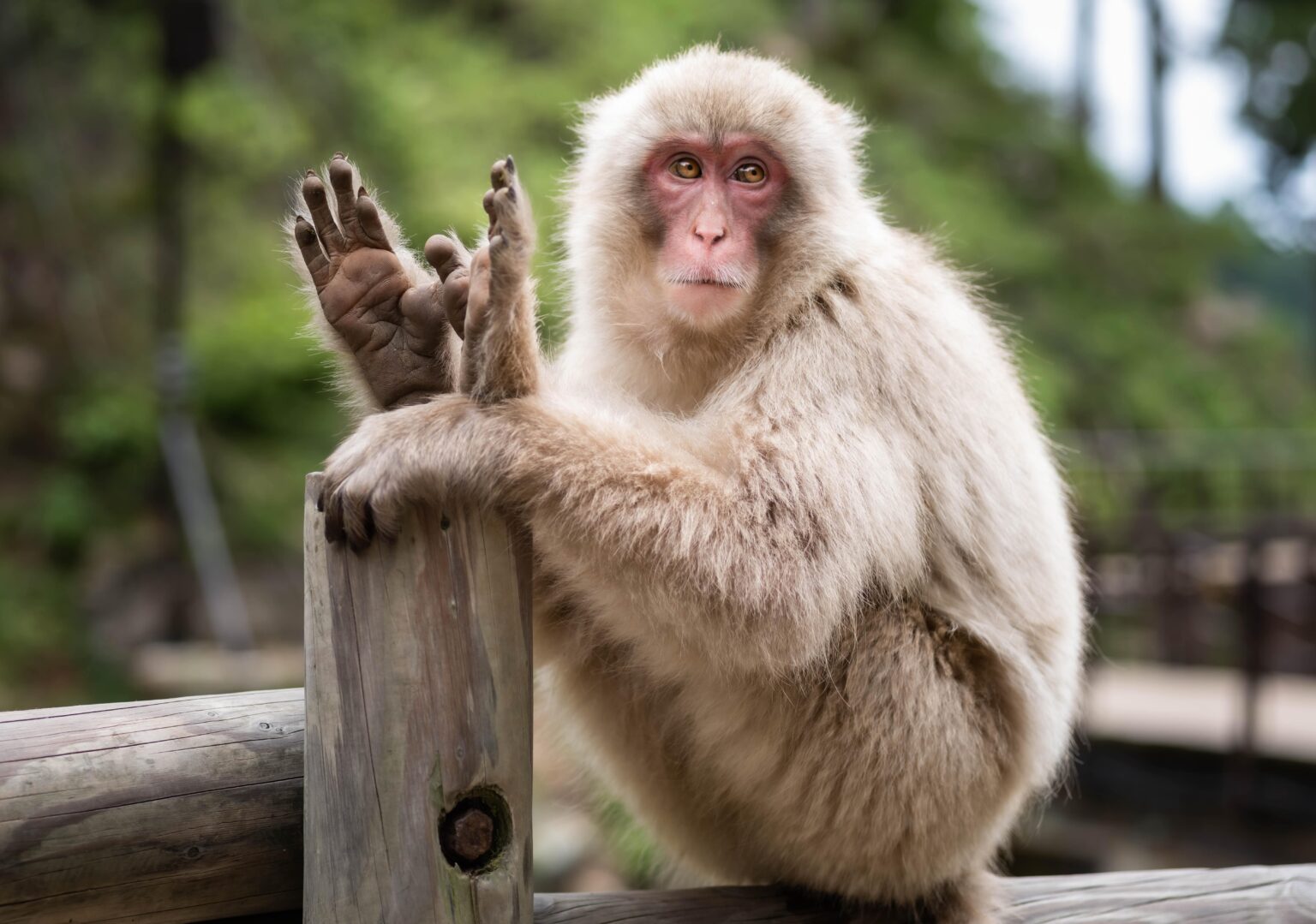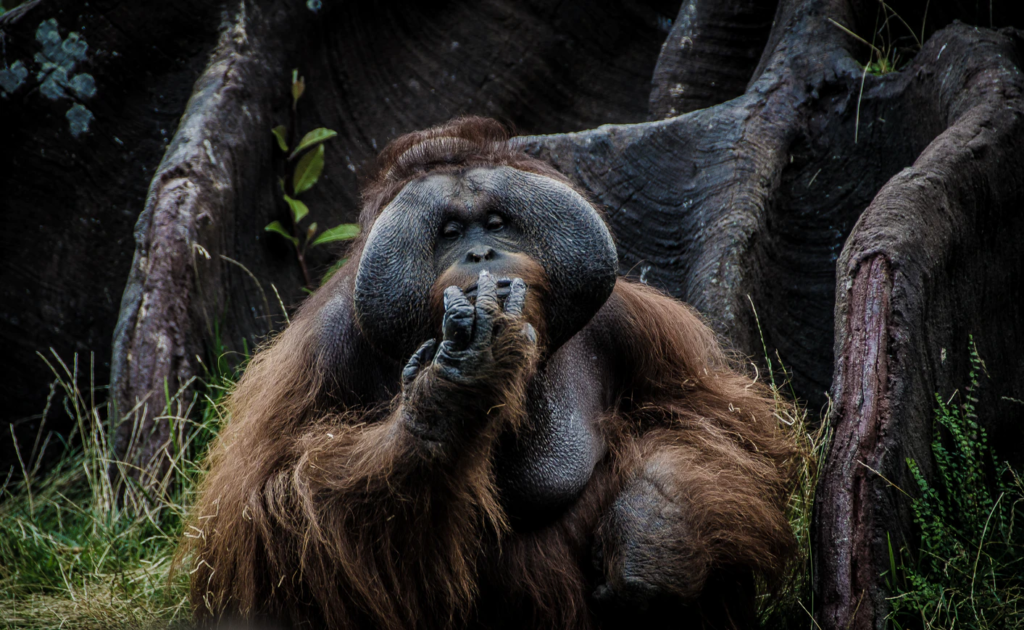Can monkeys learn to talk?
6 min read
In 2011 went out in cinemas “Rise of the Planet of the Apes”, a movie directed by Rupert Wyatt. The narrated events revolve around Cesar, a chimpanzee who inherits from the mother the effects of ALZ-11, a medicine made to boost cognitive capacities, stimulating neural receptors. During the movie, Cesar goes trough a troubled story that will lead him to be recognized as charismatic chief of a tribe of also intelligent monkeys. The essential tool that distinguishes him from a normal monkey is the knowledge of the sign language, taught him by his “adoptive father” Will Rodman, the creator of the medicine. His communicative skills will grow in the story arch until letting him to develop and using fluently human language. But it’s really possible for a chimpanzee learning to talk?

The man has always seen monkeys as the animals most likely to himself. Deeply, how it teaches us the evolution theory by Darwin, we share with them a common ancestor, that is the hominid. Therefore our cousins are always at the centre of scientific studies to discover their possibilities, that are often very satisfying and curious.
Monkeys: extraordinary capacities
One of these regards the capacity of modifying instruments. It has been observed that Fongoli chimpanzees, in Senegal, are able to serve themselves of hunt instruments, just as the human did during prehistory. Some chimpanzees have been observed while choosing carefully the branches, then cleaning them up from the leaves, working them out with teeth and hands to turn them into a sort of spears with which hunt galagidae, little nocturnal primates. A scene in which they hurl spears it’s also present in the movie Apes Revolution (2014). More instrument processing has been encountered in termites fishing. To pick them up chimpanzee stick a stick into the termite mound and collect insects with a little branch; if the termite mound is underground the stick is pushed deep and, after having cleaned with the tongue a smaller stick, this one is put into the bigger one and used as a “brush” in order to fish the termites.
Another proof of monkeyish intelligence it’s furnished by the fact that, unlikely from what Bischof and Köhler sustained, these animals, together with many others, don’t live exclusively into the present sphere but are able to conceive and make premonitions about the future. The object with which they work, in fact, are often being preserved for an eventual reuse. It’s the case of the chimpanzee Santino, in a Swedish zoo, observed while picking up some stones and levigate them with patience, then accumulate them and, in non-suspicious times, throw them against the crowd of visitors. Not being able to exploit them for an instant usage, is striking the intent of planning from these creatures. Also in orangutans and bonobos have been encountered accumulation behaviour finalized to a following reuse.

We have ascertained that monkeys are intelligent mammals able to preserve, use objects and create mental pictures in which put the future. But the question that we asked at the beginning of this article worth a million of euros. Monkeys are or are not able to talk?
To answer this question is useful to refer to Washoe, a feminine example of chimpanzee who was taught, like as in the previously mentioned fortunate series of movies, the American sign language (ASL). The monkey was totally immersed in a social environment composed of humans who communicated using only this language in her presence. In four years Washoe acquired circa 130 signs, invented some of them by herself and managed to obtain a mastery such that, for example, the sign used for “open”, which initially had learned in relation to doors, has been subsequently to require the opening of cans, illustrated books and so on. At the end of the experiment, Washoe had learned to use circa 250 different signs, some of them she was even able to transmit to other monkeys. Although more studies conducted between the 60s and the 70s had clearly shown that captivity chimpanzee are able to communicate pretty complex information through a combination of expressive signs and gestures that scholars have not yet been able to decipher.
The lip smacking
For what it concerns language it’s useful to make an observation. In macaques and geladas baboons has been observed the lip-smacking behaviour, which consists in executing movements with the mouth to transmit a positive and pleasing sign. In the geladas especially, these signs are accompanied by murmurs named “wobble”. Rising and lowering these sounds, according to a study conducted by Bergman in 2013, it almost seems to perceive a person murmuring, but it’s not finished.

In an x-ray analysis of lip-smacking, during which are produced sounds without the cords of the larynx vibrating, it has been proved that the gesture requires fast and coordinated movements, similar to the human speech. Using a contrast agent with a base of barium has been reconstructed a computerized model of the vocal apparatus of a macaques, in the way to establish which sounds is able to produce the species. The result has been that, in anatomical terms, the macaques would be able to produce sounds articulated on the 5 vocals, that is formulating sentences of complete sense. Their incapacity of speaking hasn’t therefore anatomical causes, but other types of limitations that, to date, aren’t yet very clear.
Another interesting case is the one of the Indian elephant Koshik, kept in captivity in a theme park in South Korea. Placing the trunk in the mouth was able to modulate the vocal tract and doing so he succeeded “speaking Korean”, so imitating some words in a perfectly understandable way. The curious thing is, if made listen to aware hearers, these ones recognized the words without difficulty and couldn’t barely imagine that an elephant was producing these sounds! An acoustic analysis of such verses, through spectography, has revealed that the animal was emulating the words of his instructor. Today however it doesn’t result that are animals capable of mastering the language at their own pleasure and using it responsibly.
Last curiosity about the monkeys resides in a question of influence of the gender in the game. According to some studies conducted by Alexander and Hines in 2002, the “green monkeys”, if free to choose to approach games typically “feminine” or “masculine”, will choose based on their gender. The choice of macaques Rhesus is instead stereotyped for men, while women will not show significative preferences. It’s the same attitude adopted by human beings (Brenda Todd, 2016) who, if deprived of the parent’s influence, since nine months of age, they will do stereotyped choices if boys and “generic” choices if girls. To dictate these decisions are the different specific levels of hormones and relative cerebral differences. Besides, the characteristic events of male game allow to shake, hit the ground, make noise and represent, evolutionally speaking, the same elements that we find in a display of dominance, so all that “exhibitions” that a boy does to demonstrate his superiority and intimidate the opponents. According to a further study realized by Wallen in 2015, high prenatal levels of androgens influence the masculinity in the behaviour while in the girls pathological conditions like congenital adrenal hyperplasia involves the exposition at unusual level of testosterone, which modulate the preference to male games.

Sono Sara, studentessa di lingue e culture per il commercio internazionale presso l’Università di Verona. Amo scoprire nuove culture e tradizioni attraverso il viaggio, grazie al quale mi sono appassionata alle lingue straniere, ed in particolar modo all’inglese e allo spagnolo. Tra le mie passioni figurano la danza e il canto, due discipline che mi accompagnano sin da piccola e attraverso le quali riesco ad esprimere me stessa, così come la lettura di libri, trascorrere il tempo ascoltando musica e guardare film e serie TV. Uso inoltre la scrittura (creativa e non) come valvola di sfogo per fuggire dalla realtà quando mi ci sento intrappolata. Se mi chiedessero cosa è per me la comunicazione al giorno d’oggi potrei tranquillamente dire che è uno dei vettori su cui si basa la società moderna, ed è perciò di fondamentale importanza veicolarla correttamente







